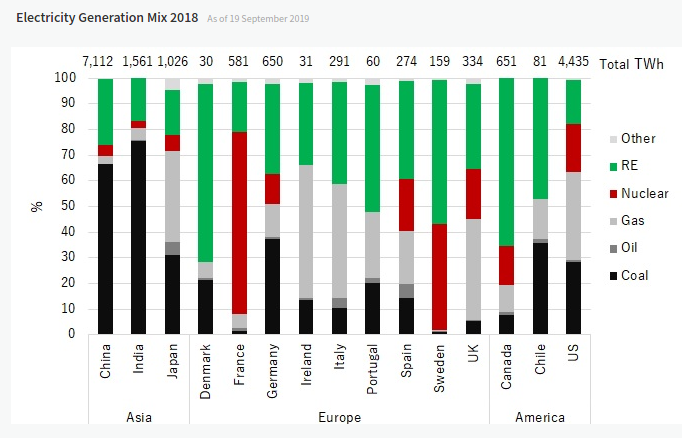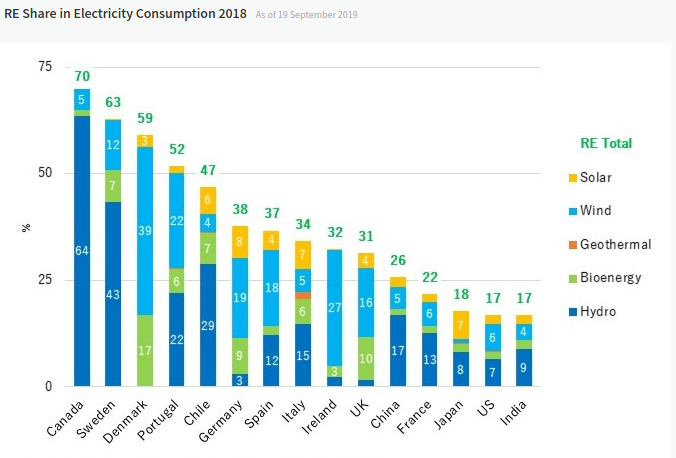February 2020
Following a family discussion on global warming, it was obvious that the carbon impact came to the table. Everyone defended in good faith the fact that renewable energies are evidence that it is our immediate duty to implement an ecological transition. Evidence is often a source of error because it is the result of opinions that reflect a total ignorance of the subject. Without trying to provide a definitive answer to a subject too complex to be tackled only in the context of a discussion or an article, we will try to shed light on energy sources and try to remain factual .
Electricity production in the world
The graph below shows the distribution of energy sources by country. In order to make the graph readable, this distribution is expressed as a percentage: the bars are of equal height. It is obvious that China consumes more electricity than Portugal. This graph shows the political and historical choices of electricity production.
The first point to emphasize is that America, as powerful as it is, produces half as much electricity as China does. The second point is that Canada which is ten times less populated than the USA produces per capita almost twice as much electricity for a carbon impact ten times lower.  FYI, the RE category means Renewable Energy covers hydroelectric, wind and solar.
FYI, the RE category means Renewable Energy covers hydroelectric, wind and solar.
It is tempting to simplify the reason for the differences observed by reducing the causes to one or two factors. If in some cases it is perfectly possible, oversimplifying does not provide any answer. However, the study of the initial conditions of a production choices makes it possible to evaluate the importance of the choices. The different elements of the choices are the availability of a resource, the state of development of a country, long-term political vision. When these three factors lose their dominance, when public opinion, the education of the population, in this case other energy production means are imposed on political leaders. In this case the choices in the modes of electricity production become more complex, the reasons for the initial choices lose their obviousness.
The development approach
In this approach, the cost and the simplicity of implementation are the predominant elements. Typically China and India, access, illustrate this problem. In China, coal is available in inexhaustible quantities, coal-fired power plants are simple to build and implement, they produce electricity that does not depend on political vagaries such as imports of coal. Unfortunately the combustion of coal emits not only carbon dioxide (carbon dioxide) but also sulfur and nitrogen oxides which, combined with rainwater, become acids that reach the ground. In the sixties the German coniferous forests were the victim of such rains. Acid rains are the basis of the birth of radical ecological movements in Europe.
In the first phase of China’s development, the drawbacks linked to this natural choice, coal, were largely offset by the progress perceived by the public opinion. Today public opinion, although largely muzzled by political power, is beginning to be heard and demands a reduction in the nuisance caused. In order to meet the demands of the population and look after its international image, China has started an ecological transition.
Nuclear
France is a centralized state. From the end of the Second World War, the production of electricity was nationalized and placed in a state company, this company is EDF. During the first half of the 20th century, coal was a significant source of conflicts between France and Germany. France has significant quantities of Uranium ore on its territory and, through its former colonies in Africa, it also has privileged access to this ore. In the name of national independence, from the birth of the IVth Republic, France has developed a civil and military nuclear sector. If nuclear power does not emit carbon dioxide, this imposes heavy constraints both in terms of operational safety as well as safety around the entire activity. Incoming and outgoing fuels are the subject of special safety attention to avoid leakage of radioactive materials to groups with intentions that are not in keeping with our way of life.
Among the technical risks of operation, we will remember Three Miles Island, Chernobyl and more recently Fukushima. We should also not forget the whole issue of reprocessing waste from nuclear power plants or the risks of nuclear terrorism linked to thefts of radioactive material. Fortunately, for the moment, terrorist blackmail against the nuclear attack remains a hypothesis, but that may not last.
If nuclear power is a possible response to the need for energy, the constraints imposed by aspects linked to security limit its harmonious development to state structures which accept both a strong centralization of security means but also checks and balances responsible for keeping the risks of such a production chain within acceptable limits. A real and constant democratic challenge that countries such as France and Sweden have imposed on themselves.
Short-term effectiveness
In contrast to China and France, the USA has acquired private means of electricity production. In the USA gas and coal are easily accessible, more than 60% of the energy produced comes from these sources. Coal mines and gas extraction are in the private domain. Unlike nuclear which requires a long-term vision and commitment, the production of fossil electricity, by its simplicity of implementation, allows short-term management. Today the US administration offers no long-term vision, it is focused on the financial efficiency of extraction (coal, gas) and means of production. The exit from the Paris agreement demonstrates the lack of will on the part of the US to integrate a global approach that is nevertheless necessary.
It is funny to say the least that two opposing political options, so-called liberal capitalism of the US and the undisputed reign of the Chinese Communist Party have both chosen similar modes of energy production.
Renewable energies
Under the guise of renewable energies are integrated many forms, hydroelectric dams, wind turbines, solar, biomass … It is interesting to segment the sources. This is the purpose of the graph below.  At the top of each bar, the number indicates the percentage of renewable energy produced in the total production of a given country.
At the top of each bar, the number indicates the percentage of renewable energy produced in the total production of a given country.
As a first remark, the four countries that produce more than 50% of their energy from renewable sources are democracies in which public opinion and the civic sense of the electorate are strong. In this respect, Portugal which lived until recent times under autocratic regimes, absolute royalty then military dictatorship, shows that a strong popular will (the Carnation Revolution) supported by trans-national integration in the EU, Portugal offers happy democratic prospects.
At the bottom of the peloton, France and the US are in very bad company when it comes to the reception of the expression of the citizens. China and its dictatorship of a misguided Communist Party, India and its nationalist populism, Japan particularly famous for its openness to otherness (but no, I’m kidding, it’s exactly the opposite) are closing the march of virtuous country on the subject of renewable energies.
In terms of renewable energy, some countries are endowed with the inexhaustible resources. Canada, through Hydro-Québec, follows a virtuous path that it is impossible to duplicate. This graph is an intellectual exercise which, in itself, justifies the pain that all of us underwent during geography lessons in high school. Who can explain that two apparently similar Scandinavian countries, Sweden and Denmark, show such different production profiles. If the memory comes back to you, it will allow you to understand the relationships between the different forms of renewable energy production.
Finally, if an element seems poorly described, false, counter intuitive, irrational, if on the contrary this article brought useful information, do not hesitate to send me your remarks, caustic, critical or constructive by clicking on the following link . Share your thoughts .
